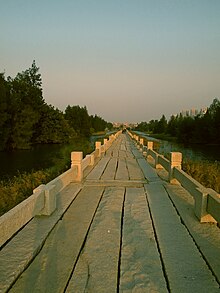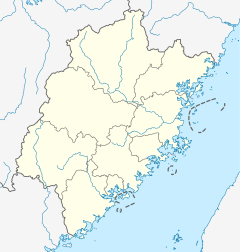Anping Bridge
|
Anping Bridge 安平桥 |
|
|---|---|

Anping Bridge, with Anhai Town in the far background
|
|
| Coordinates | 24°42′36″N 118°26′38″E / 24.7101°N 118.444°ECoordinates: 24°42′36″N 118°26′38″E / 24.7101°N 118.444°E |
| Crosses | Yangtze River |
| Locale | Quanzhou, Fujian, China |
| Characteristics | |
| Design | Beam bridge |
| Material | Stone |
| Total length | 2,070 metres (6,790 ft) |
| Width | 3 to 3.8 metres (9.8 to 12.5 ft) |
| Number of spans | 331 |
| History | |
| Construction begin | 1138 |
| Construction end | 1151 |
Anping Bridge (simplified Chinese: 安平桥; traditional Chinese: 安平橋; pinyin: Ānpíng Qiáo; Pe̍h-ōe-jī: An-pêng Kiô) is a Song dynasty stone beam bridge in China's Fujian province. It is 2,070 metres (1.29 mi) long. The bridge is also known as the Wuli Bridge (simplified Chinese: 五里桥; traditional Chinese: 五里橋; pinyin: Wǔ Lǐ Qiáo, literally Five Li Bridge) because its length is about 5 li, where a li is about 500 meters or 0.3 miles. It is a nationally protected historic site registered with the State Administration of Cultural Heritage.
The bridge lies in the prefecture-level city of Quanzhou, crossing what originally was a tidal estuary of the Shijing River (石井江) that separates the town of Anhai (in the county-level city of Jinjiang) east of the river, from the town of Shuitou (in the county-level city of Nan'an) west of the river. The bridge is named after Anhai, which was formerly known as Anping.
...
Wikipedia

